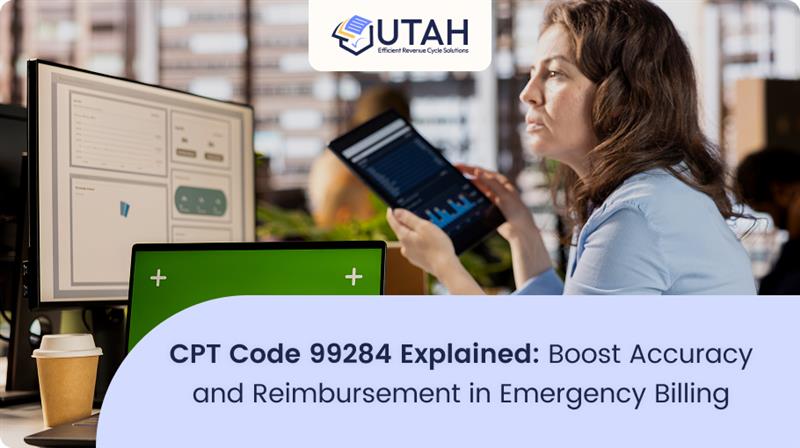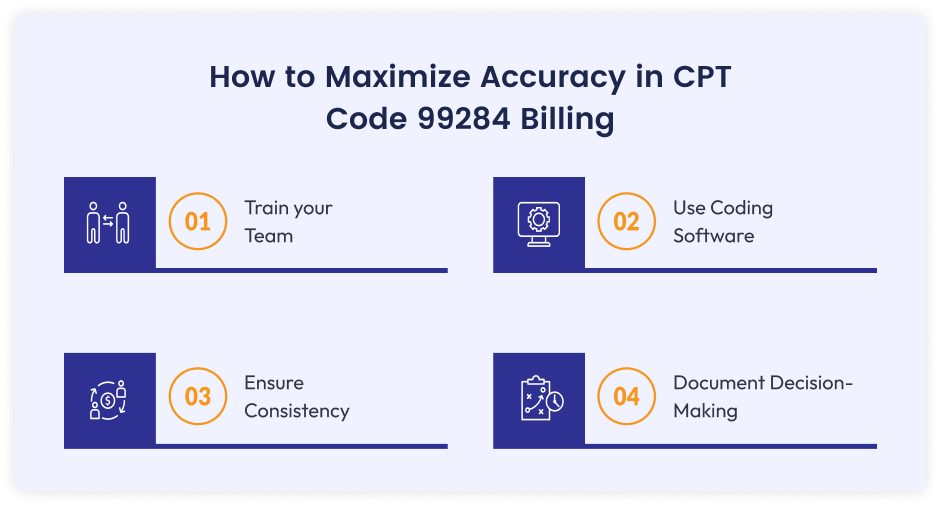CPT Code 99284 Explained: Boost Accuracy and Reimbursement in Emergency Billing
August 20, 2025

Emergency departments operate in fast-paced, high-pressure environments where accurate documentation and coding often compete with urgent patient care demands. One common challenge EDs face is ensuring correct billing for evaluation and management (E/M) services—especially when applying CPT code 99284.
Misunderstanding or misapplying this code can cause underpayment, claim denials, or audits, putting revenue and compliance at risk. Despite its frequent use, CPT 99284 remains one of the most scrutinized codes in ED billing due to inconsistent documentation and confusion about what qualifies as moderate complexity medical decision-making.
This guide helps ED providers and billing teams understand what CPT 99284 represents, when to use it, how to document it accurately, and how to avoid costly errors that trigger audits or revenue loss. By mastering this code, emergency departments improve billing accuracy, ensure compliance, and secure fair reimbursement for the critical care they provide.
CPT 99284 is an evaluation and management (E/M) code used in the emergency department (ED) for patients who need urgent attention but are not in immediate danger. It applies when the visit involves moderate medical complexity—meaning the provider must assess a potentially serious issue, order tests, and make decisions that carry a moderate risk.
Typical conditions seen under CPT 99284 include:
To bill CPT 99284, documentation must support:
In the fast-moving ED environment, CPT 99284 accurately reflects the true complexity of care, supports proper reimbursement, and reduces billing errors or denials. This code is essential for capturing the time, skill, and clinical judgment required to treat moderately ill or injured patients.
However, CPT 99284 is inappropriate for simple conditions, such as minor injuries, where decision-making remains minimal.
Therefore, CPT 99284 plays a crucial role in documenting and reporting emergency department visits, helping providers accurately record the level of care and medical complexity for billing and reimbursement.

Healthcare practitioners and hospitals rely on CPT code 99284 to document, bill, and receive reimbursement for emergency department (ED) visits. This code represents a moderate level of service—more complex than minor injuries or routine issues, but less severe than life-threatening emergencies.
Emergency physicians often evaluate patients with unclear symptoms or conditions that require immediate attention but don’t reach high-acuity levels. CPT code 99284 captures this intermediate level of complexity—for example, abdominal pain that involves lab tests and imaging, or an asthma flare-up needing urgent but not critical care.
By using CPT 99284, providers accurately reflect the time, effort, and clinical decision-making involved in managing these cases.
Proper use of CPT 99284 enables facilities and providers to receive fair reimbursement for the services and procedures they deliver in emergency department care. These visits visually require:
Auditors and payers, including insurance companies, examine Medicare and Medicaid emergency claims more closely. Upcoding is a common audit trigger, along with discrepancies between the documented care and the billed code.
CPT 99284 allows providers to code confidently when the documentation supports moderate decision-making complexity.
By carefully documenting the patient’s history, examination, and medical decision-making, healthcare providers build a strong defense against audit challenges.
Transparent and compliant documentation demonstrates that billing procedures are both transparent and appropriate.
To use CPT Code 99284 correctly, providers must meet specific requirements based on the patient’s history, examination, and medical decision-making during the visit.
Providers use CPT 99284 when the patient’s history includes these conditions:
CPT 99214 requires a detailed examination involving different organ systems such as cardiovascular, respiratory, gastrointestinal, and neurological. Providers must document key findings from the physical exam. They should tailor the examination to the patient’s symptoms and history, covering the relevant body areas.
To bill CPT 99284, the provider’s medical decision-making must be moderately complex. It means the provider is dealing with a case that requires thoughtful evaluation and care, but it’s not the most severe or critical level. Here’s what that includes:
All three elements work together to support CPT 99284 when properly documented.
Emergency care providers—whether in hospital emergency departments or private urgent care clinics—use CPT code 99284 when:
CPT 99284 applies to situations that require timely intervention, where the provider’s clinical judgment plays a crucial role in managing potentially serious but stable conditions.
For example:
A patient with severe abdominal pain and a suspected diagnosis of appendicitis may require a detailed exam, lab tests (such as blood work), an ultrasound, and further consultations. In this case, the medical decision-making is moderate because the doctor must determine whether surgery is necessary or if treatment alone will be effective.
Understanding CPT code 99284 becomes easier when you compare it with other E/M codes used in emergency billing.
Below, we elaborate on how CPT code 99284 relates to other evaluation and management codes.
| 99283 | CPT Code used for low-level complexity visits. It involves less detailed history and examination, with straightforward medical decision-making for lower complexity. It applies to a patient with minor to moderate symptoms who does not require extensive evaluation or treatment. |
| 99284 | CPT Code used for moderate to high complexity visits. It is appropriate for this level when the patient has a condition requiring a detailed history, examination, and moderate complexity medical decision-making. The patient must have a more serious disease than those billed under 99283 but not as serious as those requiring 99285. It also involves evaluating and managing acute illness or injury, posing a moderate diagnosis, or initiating complex treatment plans. |
| 99285 | Used in high-complexity visits involved severe, potentially life-threatening conditions. Requires extremely complicated medical decision-making in addition to a detailed history and examination. Patients with unstable or serious illnesses who need prompt, thorough evaluation and treatment are eligible to use this code. |
Differences:
The significant difference between CPT Codes 99283,99284, and 99285 lies in the complexity of medical decision-making and the severity of the patient’s condition.
| 99283 | Used for less severe cases and also for low-complexity cases. |
| 99284 | Used for moderate to high complexity cases with mild severity, involving more detailed evaluation and management. |
| 99285 | Used for the highest complexity and most severe or life-threatening cases. |
Assigning accurate CPT code 99284 to the correct procedures you have performed in ED will help you receive faster reimbursements.
On the other hand, wrong code may lead to undercoding and cause revenue loss. Additionally, if there is overcoding, you may encounter audit risks resulting in legal and financial penalties.
Here’s how you can boost reimbursement while staying compliant:
Document Everything Thoroughly:
Follow Updated Coding Guidelines: The AMA (American Medical Association) and CMS (Centers for Medicare & Medicaid Services) regularly update coding standards. Staying informed about these changes and applying them to your documentation practices is crucial.
Do not Upcode: Avoid using CPT 99285 when 99284 is more appropriate. Overbilling can lead to audits and fines.
Use modifiers correctly when billing CPT 99284 to ensure proper reimbursement and avoid denials—especially when providers perform additional procedures during the same visit.
Understand Payer-Specific Guidelines: The criteria for moderate complexity can vary depending on the payer. To avoid claim denials and ensure compliance, constantly review payer-specific rules.

The critical step in ensuring correct billing for CPT 99284 is to be aware of its necessary elements and the typical errors that might result in downcoding or denials.
As previously stated, 99284 is a moderately complex ED visit that requires accurate and comprehensive documentation to support the quality of care and obtain full reimbursement.
Ensure that all team members, coders, and providers receive comprehensive training. Everyone working with documentation or codes must understand the required elements for CPT 99284. Avoid guessing or taking shortcuts.
Provide regular training to your staff, address any knowledge gaps, and conduct frequent audits. Accuracy is a choice—it happens when you build it into your workflow.
If you are using coding software, do not ignore built-in instructions. Their purpose is to protect your correctness, compliance, and financial success.
Maintain consistent use of CPT 99284, implement documentation practices, use coding checklists, and conduct routine audits. Ensure that every case fulfills the requirements, including thorough history and examinations, and somewhat complicated medical decision-making, and align all coding decisions with CPT guidelines. To ensure accuracy and compliance, coders and suppliers must communicate properly.
Document the history and exam thoroughly, and clearly explain the moderate complexity in the decision-making process. This clarity helps providers consider all relevant factors, recognize possible risks, and make the reasoning behind the decision understandable to everyone involved.
Recognizing and accurately using CPT Code 99284 is crucial for obtaining proper reimbursement for moderate-complexity emergency department visits. Keeping focused on documentation and aligning with current coding guidelines, healthcare practitioners can improve billing accuracy, overcome the risk of denials, and ensure compliance. With the correct data and support, such as working with experienced professionals like Utah Medical Billing Services, you
Maximizing reimbursement with CPT 99284?
Let Utah medical billing services help you optimize your coding accuracy, streamline claims, and ensure you get paid what you deserve. Be a partner with Utah Billing Services and our expert team to maximize your CPT 99284 reimbursement today!